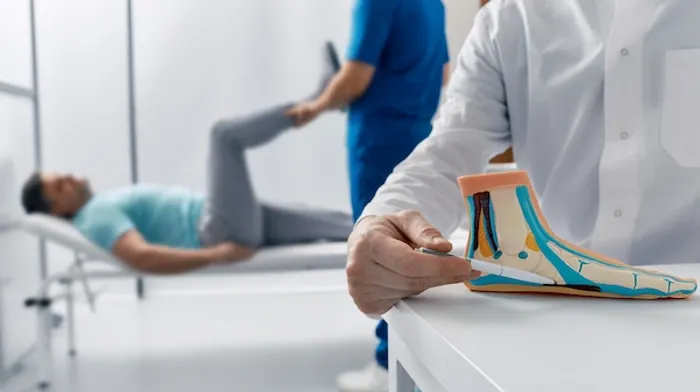Guide to Do You Have Flat Feet
Discover if you have flat feet with our simple guide. Learn the symptoms, a quick at home test, and what to do if you have fallen arches. Get the answers you need now!


Flat Feet: Causes, Symptoms, and Effective Treatment Options
Introduction
Have you ever looked at your footprint in the sand and noticed your entire sole left a mark, with no distinct arch? If so, you might have a common condition known as flat feet, or pes planus. While many people with flat feet experience no pain or problems, for others, it can be a source of persistent discomfort that affects their ankles, knees, and even their back. This comprehensive guide will help you understand what it means to have flat feet, separating myth from fact. We'll explore the different types, from flexible to rigid, identify the key symptoms to watch for, and delve into the most effective treatment options available—from supportive shoes and simple exercises to when it might be time to see a professional. Whether you're seeking answers for yourself or your child, this article will provide the clarity and next steps you need for optimal foot health.
Understanding the Two Main Types of Flat Feet
Not all flat feet are the same. The key to proper management lies in identifying which type you have, as their implications and treatments differ significantly.
Flexible Flat Feet (The Most Common Type)
This is by far the most prevalent form. If you have flexible flat feet, your arch is visible when you sit or stand on your tiptoes but disappears when you place your foot flat on the ground. The arch is present but collapses under full body weight due to loose connective tissues and ligaments. This type often begins in childhood or adolescence and continues into adulthood. While many people with flexible flat feet are asymptomatic, some may experience pain that worsens with activity. The flexibility of the joint is a good sign, as it often responds very well to nonsurgical treatments like orthotics and specific strengthening exercises.
Rigid Flat Feet (A More Serious Condition)
In this less common type, the arch is absent regardless of whether the foot is bearing weight or not. The foot is essentially stiff, with limited side to side and up and down motion. Rigid flat feet often develop during the teenage years and worsen in adulthood. This condition is usually more painful than the flexible variant and can significantly interfere with daily activities. The cause is often related to an underlying problem with the bones or tarsal coalition (an abnormal connection between bones in the back of the foot). Due to its complex nature, rigid flat feet require a thorough medical evaluation to diagnose the root cause and determine the appropriate treatment plan, which may include more advanced interventions.
Consult a General Physician for the best advice
What Causes Flat Feet? From Genetics to Injury
The origins of flat feet can be congenital (present at birth) or acquired later in life due to various factors.
Common Causes in Adults
Many adults who had normal arches develop fallen arches over time. This can be due to:
- Aging: Natural wear and tear on the posterior tibial tendon, the main tendon supporting the arch, can cause it to weaken and stretch.
- Posterior Tibial Tendon Dysfunction (PTTD): This is a primary culprit. Injury or inflammation of this tendon renders it unable to provide adequate support.
- Injury: Fractures or severe sprains to the foot or ankle can alter its structure.
- Medical Conditions: Arthritis (especially rheumatoid arthritis) and diabetes can contribute to structural changes and nerve damage in the foot.
- Obesity: Excess body weight places constant additional stress on the tendons and ligaments that maintain the arch.
Flat Feet in Children: When Is It Normal?
It's perfectly normal for infants and toddlers to have flat feet. A fat pad typically covers the arch, and the foot's bones and tendons are still developing. Most children develop a visible arch by age 6. However, if the flat feet are rigid, painful, cause a limp, or only affect one foot, it's wise to consult a pediatrician or podiatrist. Persistent painful flat feet in children should not be ignored.
Recognizing the Symptoms: More Than Just a Lack of an Arch
While a missing arch is the defining characteristic, the symptoms of flat feet are what drive people to seek help.
Common Signs and Discomfort
- Pain is the most common complaint, but it's not always located in the arch itself. People often experience:
Foot pain: Especially in the arch or heel area. - Ankle pain or swelling: Along the inside of the ankle.
- Pain that radiates: Up the leg to the calf, knee, or even the hip and lower back due to altered gait (overpronation).
- Difficulty with certain activities: Pain that worsens with activity like running or walking for long periods.
- Uneven shoe wear: Shoes, especially on the inside of the sole, may wear out more quickly.
Potential Long Term Complications if Untreated
Ignoring painful flat feet can lead to other problems due to the biomechanical changes in how you walk. These complications can include:
- Plantar fasciitis: Inflammation of the band of tissue that runs along the bottom of your foot.
- Achilles tendinitis: Stress on the Achilles tendon.
- Bunions and hammertoes: Resulting from the foot's instability.
- Shin splints: Pain in the front of the lower leg.
- Arthritis: In the foot and ankle joints over time.
If you are experiencing persistent pain or any of these secondary issues, it's important to get a professional opinion. If your symptoms persist beyond two weeks, consult a doctor online with Apollo24|7 for further evaluation.
How Are Flat Feet Diagnosed? The Wet Test and Beyond
Diagnosis is typically straightforward, starting with a simple home check.
The Simple AtHome "Wet Test"
This is a quick way to check your foot type:
1. Wet the sole of your foot.
2. Step onto a flat, dry surface that will show your footprint, like a brown paper bag or concrete.
3. Step away and observe.
- Normal arch: You'll see a clear dry space between the heel and ball of the foot.
- Low or flat arch: Your footprint will show almost the entire sole of your foot.
When to See a Doctor: Professional Diagnosis?
A healthcare professional will go further. They will:
- Observe your feet while you stand and walk.
- Check your range of motion.
- Look at your wear patterns on your shoes.
- Possibly order imaging tests like Xrays or an MRI to get a detailed view of the bones and soft tissues, especially if rigid flat feet or a tendon tear is suspected. This is crucial for creating an effective treatment plan for pes planus.
Non Surgical Treatment and Management Strategies
The vast majority of flat feet cases are managed successfully without surgery. The goals are to reduce pain, improve function, and prevent complications.
The Power of Supportive Shoes and Orthotics
This is the first and most important line of defense. Supportive shoes with a firm midsole and good arch support are essential. Orthotics (custommade or over the counter arch supports) are highly effective. They work by cushioning the arch and correcting biomechanical alignment, which can alleviate pain not just in the foot but also in the knees and back.
Targeted Stretches and Strengthening Exercises
Specific exercises for flat feet can strengthen the arch and improve flexibility.
- Heel Cord Stretch: Lean against a wall with one knee straight and the other bent to stretch your Achilles tendon and calf muscles.
- Arch Lifts: While sitting or standing, keep your foot flat on the floor and try to lift your arch without curling your toes.
- Toe Yoga: Practice lifting only your big toe while keeping the other four down, and then vice versa.
- Rolling: Use a frozen water bottle or tennis ball to roll under the arch of your foot for massage and relief.
Lifestyle Modifications and Pain Management
- Weight management: Losing weight can significantly reduce stress on the feet.
- Activity modification: Switch from high impact activities like running to lower impact ones like swimming or cycling during flareups.
- OTC pain relievers: Medications like ibuprofen can help manage pain and inflammation.
- Physical therapy: A therapist can provide a tailored exercise program and techniques to improve gait.
If your condition does not improve after trying these methods, book a physical visit to a doctor with Apollo24|7 for a personalized treatment plan.
Surgical Options: A Last Resort for Severe Cases
Surgery is only considered when prolonged nonsurgical methods have failed to relieve severe pain and the condition is drastically limiting quality of life. Procedures are complex and aim to correct the bone alignment and/or repair tendons. Recovery can be lengthy. It is absolutely a last resort option.
Living Well with Flat Feet: Sports, Daily Life, and Prevention
Having flat feet doesn't mean you can't be active. Many professional athletes have flat feet. The key is choosing the right shoes for your foot type. Look for "stability" or "motion control" athletic shoes. Focus on sports that are naturally kinder to flat feet, like swimming and cycling, and ensure you properly warm up and stretch. While you can't always prevent flat feet, maintaining a healthy weight and wearing supportive shoes can go a long way in preventing painful symptoms.
Consult a General Physician
Conclusion
Understanding your flat feet is the first step toward managing them effectively. For most, it's a harmless anatomical variation, but for those experiencing pain, a wide range of effective solutions exists. From investing in the best supportive shoes and orthotics to committing to a routine of simple strengthening exercises, you have significant power to alleviate discomfort and improve your foot health. Remember, listening to your body is key. While this guide provides a strong foundation, persistent or severe pain is a clear signal to seek professional guidance. A healthcare provider can offer a precise diagnosis and a tailored treatment plan to keep you moving comfortably. Take the insights from this article, take that next step, and walk towards a more painfree life.
Consult a General Physician

Dr. Shesham Srinidhi
General Practitioner
5 Years • MD(physician)
Hyderabad
Apollo 24|7 Clinic, Hyderabad
(150+ Patients)

Dr. Siri Nallapu
General Practitioner
5 Years • MBBS
Hyderabad
Apollo 24|7 Clinic, Hyderabad

Dr. Rajib Ghose
General Physician/ Internal Medicine Specialist
25 Years • MBBS
East Midnapore
VIVEKANANDA SEBA SADAN, East Midnapore

Dr. Anand Misra
General Physician/ Internal Medicine Specialist
14 Years • MBBS, DNB
Mumbai
Apollo Hospitals CBD Belapur, Mumbai

Dr. R Gopakumar
Internal Medicine/ Covid Consultation Specialist
31 Years • MBBS, MD(general medicine
Angamaly
Apollo Hospitals Karukutty, Angamaly
(25+ Patients)
Consult a General Physician for the best advice

Dr. Shesham Srinidhi
General Practitioner
5 Years • MD(physician)
Hyderabad
Apollo 24|7 Clinic, Hyderabad
(150+ Patients)

Dr. Siri Nallapu
General Practitioner
5 Years • MBBS
Hyderabad
Apollo 24|7 Clinic, Hyderabad

Dr. Rajib Ghose
General Physician/ Internal Medicine Specialist
25 Years • MBBS
East Midnapore
VIVEKANANDA SEBA SADAN, East Midnapore

Dr. Anand Misra
General Physician/ Internal Medicine Specialist
14 Years • MBBS, DNB
Mumbai
Apollo Hospitals CBD Belapur, Mumbai

Dr. R Gopakumar
Internal Medicine/ Covid Consultation Specialist
31 Years • MBBS, MD(general medicine
Angamaly
Apollo Hospitals Karukutty, Angamaly
(25+ Patients)
Frequently Asked Questions
Can flat feet be corrected in adults?
In adults, the goal is typically management and pain relief rather than permanent 'correction.' While you can't usually change the underlying structure without surgery, nonsurgical methods like orthotics and exercises can effectively rebuild functional strength and eliminate symptoms, effectively creating a 'supported' arch.
What are the best shoes for flat feet?
Look for shoes with excellent arch support, a firm heel counter (the back part of the shoe), and a straight or semicurved last (the shape of the sole). Brands often have 'stability' or 'motion control' lines designed specifically for overpronation, which is common with flat feet.
Is having flat feet a disability?
Not typically. Flat feet are only considered a disabling condition if they cause severe, chronic pain that significantly limits walking and standing, and if all treatment options have failed to provide relief. This is a determination made by a medical professional.
Can I join the military or police with flat feet?
Policies have changed. Many organizations now allow enlistment with asymptomatic flat feet. If the condition is painful or limits physical performance, it may be disqualifying. It's best to check the specific medical requirements of the institution.
What is the difference between flat feet and fallen arches?
These terms are often used interchangeably. Technically, 'fallen arches' implies that an arch was once present and has now collapsed, which is an acquired condition in adults. 'Flat feet' is a broader term that can describe both feet that never developed an arch and fallen arches.